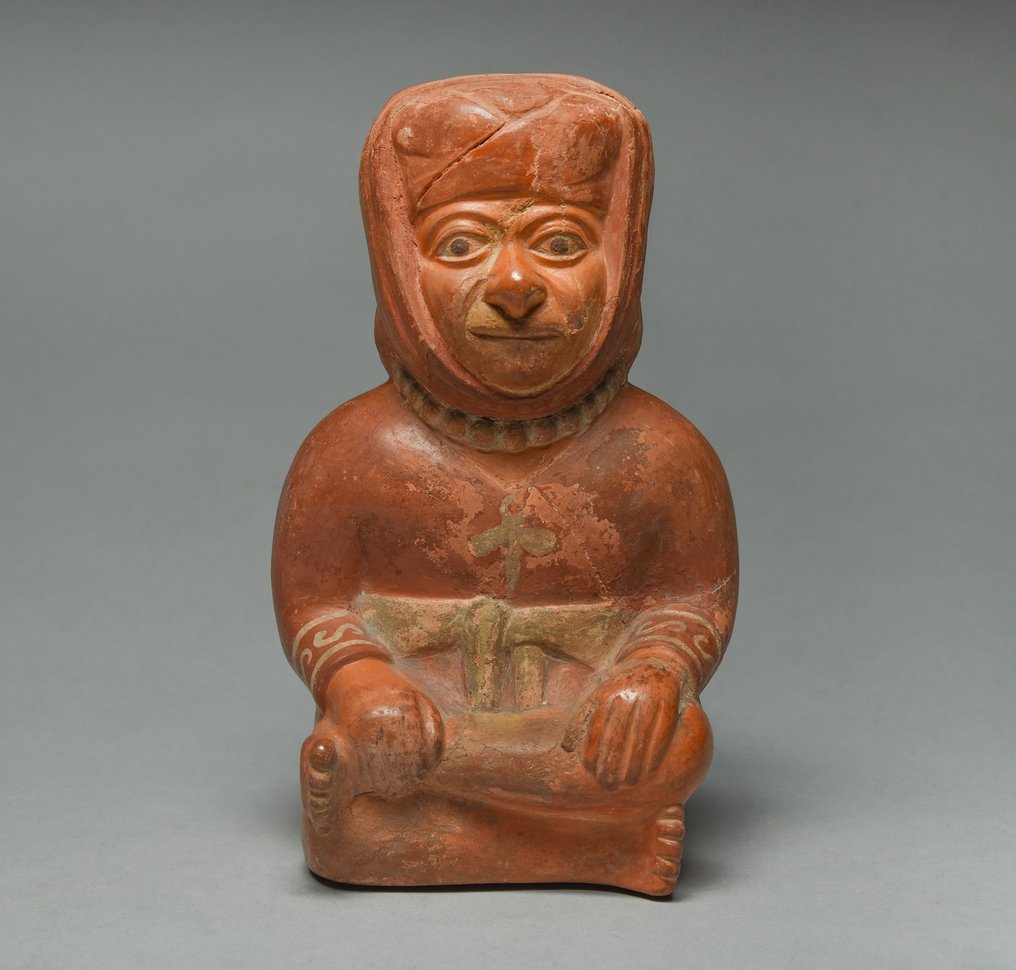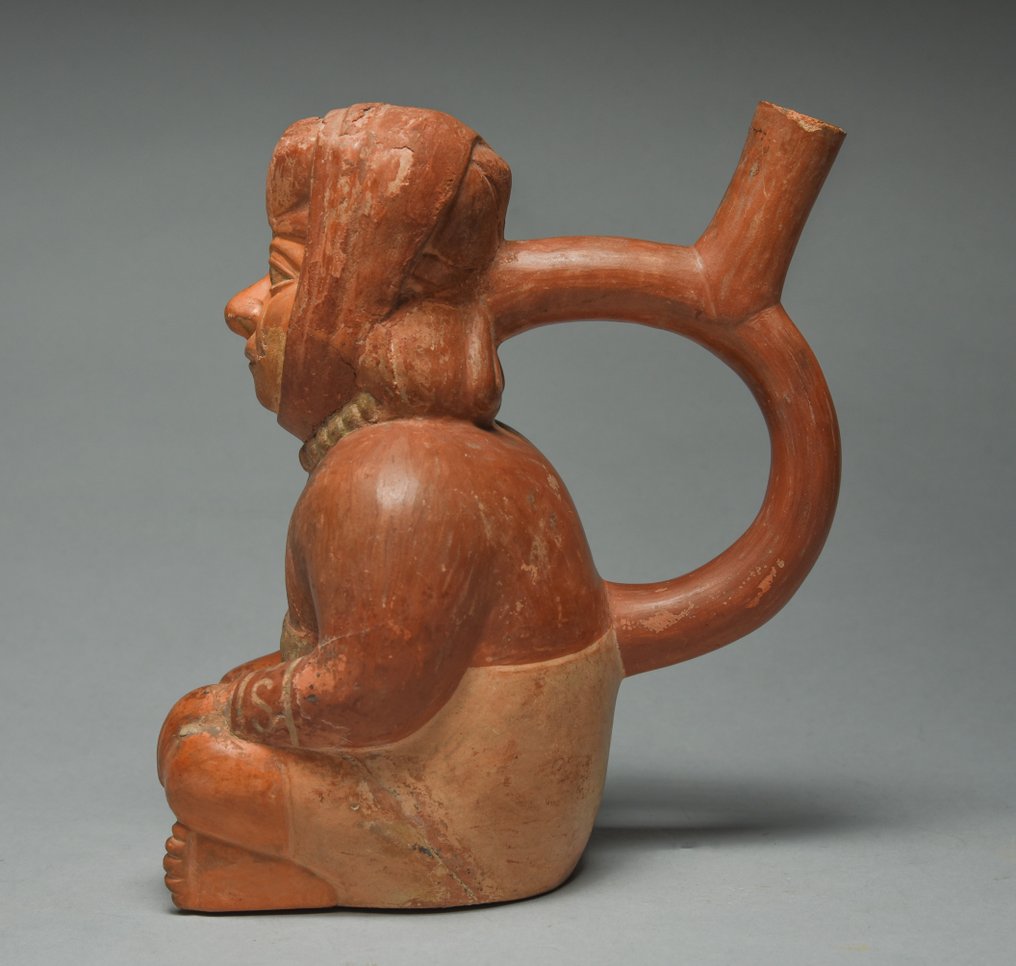Magnífica la entrega y el objeto. Perfecta la sonido del sibato
Zobacz tłumaczenieMoche, Peru Terakota Huaco z rączką w kształcie strzemienia w kształcie dostojnika. 300-500 n.e. Wysokość 21 cm. Import
Nr 88173445



Huaco with stirrup handle in the shape of a dignitary.
CULTURE: Moche, Perú
PERIOD: 300-500 AD
MATERIAL: Terracotta
DIMENSIONS: Height 21 cm and 18.5 cm length
CONDITION: Good condition, has a diagonal crack, professionally restored.
PROVENANCE: Private collection, United Kingdom. Purchased at Christie's, London, March 24, 1992, lot 23.
DESCRIPTION:
The Moche culture inhabited the coast of present-day northern Peru, concentrating in the valleys of Lambayeque, Chicama, Moche and Virú. This desert region is crossed by several rivers that flow down into the Pacific Ocean, where marine resources are plentiful.
The Moche produced fine ceramic, textile and precious metal pieces. Their characteristic style can be seen in a wide range of goods such as fire-engraved gourds, wall murals, featherwork art, body painting and tattoos. Their ceramic decoration displays a level of skill that has rarely been surpassed, and included such techniques as incision, bas-relief with stamps, and painting on smooth surfaces. Many were made in state-run workshops that mass-produced pieces from molds. Their ceramics came in a variety of forms and decorative styles and displayed myths and ritual motifs as well. Notable among these earthenware forms were the so-called “portrait bottles”, bottles molded with the face of a well-known Moche figure. These highly detailed facial portraits reflect the Moche’s own use of face paint and/or tattoos, as well as elaborate headdresses. This portrait-making expertise can also be observed in everyday scenes and erotic representations, as well as in figures of individuals that were hunch backed, blind, or suffered from other disorders. They were skillful metalworkers, using gold, copper and silver to make ear ornaments, nose rings, bracelets, necklace beads, tweezers and a variety of tools. Especially notable is the tumi or ceremonial knife that was usually only carried by Moche officials.
Many of the motifs adorning early Moche ceramics were derived from the Recuay culture. These two peoples were certainly in contact, as all of the irrigation waters the Moche used in their valleys flowed down from Recuay territory. In the early years, the Moche also had contact with groups of the Salinar and Gallinazo cultures. It is very likely that the Moche disappeared when they were overtaken by the Wari Empire, but their civilization also suffered from long periods of flooding by the El Niño phenomenon, which would have destroyed their farming infrastructure and could have helped precipitate their collapse. The final stage of the Moche culture displays features that would later appear in the Chimú culture.
Notes:
The seller guarantees that he acquired this piece according to all national and international laws related to the ownership of cultural property. Provenance statement seen by Catawiki.
The seller will take care that any necessary permits, like an export license will be arranged, he will inform the buyer about the status of it if this takes more than a few days.
The piece includes authenticity certificate.
The piece includes Spanish Export License.
Historie sprzedawców
Huaco with stirrup handle in the shape of a dignitary.
CULTURE: Moche, Perú
PERIOD: 300-500 AD
MATERIAL: Terracotta
DIMENSIONS: Height 21 cm and 18.5 cm length
CONDITION: Good condition, has a diagonal crack, professionally restored.
PROVENANCE: Private collection, United Kingdom. Purchased at Christie's, London, March 24, 1992, lot 23.
DESCRIPTION:
The Moche culture inhabited the coast of present-day northern Peru, concentrating in the valleys of Lambayeque, Chicama, Moche and Virú. This desert region is crossed by several rivers that flow down into the Pacific Ocean, where marine resources are plentiful.
The Moche produced fine ceramic, textile and precious metal pieces. Their characteristic style can be seen in a wide range of goods such as fire-engraved gourds, wall murals, featherwork art, body painting and tattoos. Their ceramic decoration displays a level of skill that has rarely been surpassed, and included such techniques as incision, bas-relief with stamps, and painting on smooth surfaces. Many were made in state-run workshops that mass-produced pieces from molds. Their ceramics came in a variety of forms and decorative styles and displayed myths and ritual motifs as well. Notable among these earthenware forms were the so-called “portrait bottles”, bottles molded with the face of a well-known Moche figure. These highly detailed facial portraits reflect the Moche’s own use of face paint and/or tattoos, as well as elaborate headdresses. This portrait-making expertise can also be observed in everyday scenes and erotic representations, as well as in figures of individuals that were hunch backed, blind, or suffered from other disorders. They were skillful metalworkers, using gold, copper and silver to make ear ornaments, nose rings, bracelets, necklace beads, tweezers and a variety of tools. Especially notable is the tumi or ceremonial knife that was usually only carried by Moche officials.
Many of the motifs adorning early Moche ceramics were derived from the Recuay culture. These two peoples were certainly in contact, as all of the irrigation waters the Moche used in their valleys flowed down from Recuay territory. In the early years, the Moche also had contact with groups of the Salinar and Gallinazo cultures. It is very likely that the Moche disappeared when they were overtaken by the Wari Empire, but their civilization also suffered from long periods of flooding by the El Niño phenomenon, which would have destroyed their farming infrastructure and could have helped precipitate their collapse. The final stage of the Moche culture displays features that would later appear in the Chimú culture.
Notes:
The seller guarantees that he acquired this piece according to all national and international laws related to the ownership of cultural property. Provenance statement seen by Catawiki.
The seller will take care that any necessary permits, like an export license will be arranged, he will inform the buyer about the status of it if this takes more than a few days.
The piece includes authenticity certificate.
The piece includes Spanish Export License.
Historie sprzedawców
- 823
- 10
- 1
very well packed with all the documents included, thnks
Zobacz tłumaczenieGreat object. Really beautiful. Quick delivery. Excellent.
Zobacz tłumaczenieSuperbe objet, Service d'Arqueologia Ancient Art excellent et rapide. Jaume Bagot toujours parfait .
Zobacz tłumaczenieTodo perfecto gracias
Zobacz tłumaczenieNice item all ok A+++
Zobacz tłumaczenieThank you for this Oinochoe, one question: did you as promised read my post!
Zobacz tłumaczenieVery cooperative in every aspect of the transaction.
Zobacz tłumaczenieAlways a great pleasure!
Zobacz tłumaczenieFine quality, good service. Thanks.
Zobacz tłumaczenieMuy amables, muy bien todo. Gracias
Zobacz tłumaczenieAlles bestens
Zobacz tłumaczenieexactly as described and shipped safely and punctually.
Zobacz tłumaczenieschnelle Lieferung sehr sichere Verpackung alles bestens
Zobacz tłumaczenietres bel objet je le recherchai depuis longtemps envoi rapide et protégé je pense qu'il y aura d'autres achats avec ce vendeur merci +++++++
Zobacz tłumaczenieEinfach nur toll
Zobacz tłumaczenieTodo perfecto
Zobacz tłumaczenieottimo
Zobacz tłumaczenieperfetto
Zobacz tłumaczenietop oggetto bellissimo grazie 💯💯💯💯💯💯 :-)
Zobacz tłumaczenieI bought this beautiful artifact together with artifact from Mr. Bagot but although it is clearly stated on his shipping page that when purchasing multiple artifacts i paid the double package costs
Zobacz tłumaczenieI bought this beautiful artifact together with artifact from Mr. Bagot but although it is clearly stated on his shipping page that when purchasing multiple artifacts i paid the double package costs
Zobacz tłumaczenieBel objet, bien emballé. Parfait.
Zobacz tłumaczeniewonderful faiece and very fast shipping.thanks a lot
Zobacz tłumaczenieJ Bagot es un profesional excelente. Sus artículos son de gran calidad, se incluye la documentación necesaria y el embalaje se realiza con esmero. Le recomiendo encarecidamente.
Zobacz tłumaczenie- 823
- 10
- 1
Magnífica la entrega y el objeto. Perfecta la sonido del sibato
Zobacz tłumaczenieKlauzula
Sprzedawca gwarantuje i może udowodnić, że przedmiot został nabyty legalnie. Sprzedawca został poinformowany przez firmę Catawiki, że musi dostarczyć dokumentację wymaganą przez przepisy ustawowe i wykonawcze obowiązujące w jego kraju zamieszkania. Sprzedawca gwarantuje i jest uprawniony do sprzedaży/eksportu tego przedmiotu. Sprzedawca przekaże nabywcy wszystkie znane informacje o pochodzeniu przedmiotu. Sprzedawca zapewnia, że wszelkie niezbędne pozwolenia są/zostaną załatwione. Sprzedawca niezwłocznie poinformuje nabywcę o wszelkich opóźnieniach w uzyskaniu takich zezwoleń.
Sprzedawca gwarantuje i może udowodnić, że przedmiot został nabyty legalnie. Sprzedawca został poinformowany przez firmę Catawiki, że musi dostarczyć dokumentację wymaganą przez przepisy ustawowe i wykonawcze obowiązujące w jego kraju zamieszkania. Sprzedawca gwarantuje i jest uprawniony do sprzedaży/eksportu tego przedmiotu. Sprzedawca przekaże nabywcy wszystkie znane informacje o pochodzeniu przedmiotu. Sprzedawca zapewnia, że wszelkie niezbędne pozwolenia są/zostaną załatwione. Sprzedawca niezwłocznie poinformuje nabywcę o wszelkich opóźnieniach w uzyskaniu takich zezwoleń.









